What is a Kobold?
In folklore, there is noticeable debate as to whether a kobold is a sort of lizard or a sort of dog. They are well known for being snivelling, impish, and generally up to no good. At least one internet user has described the lizard variant as "a dragon, but make it a chihuahua." Here at AvantGoblin, the conclusion is all of these. Kobolds are strange little semi-reptillian things with hair, beaks, and fin-flaps. The hair can be just on the head or spread over the body. The beaks can be full snoots or just little clicky bitey things, and may be jagged enough to contain or resemble teeth. The fins are not at all useful in an aquatic setting, and may function as something between ears and horns, but they come in very handy for the more bat-ear-dependent linguistics of goblins. Their design at this time is based loosely on a leopard gecko by way of a bearded dragon, but more variants are being worked on. They come in a wide variety of colors and patterns, and are roughly goblin-sized, give or take. Kobolds have perfectly normal bones, scaly-seeming skin that is surprisingly soft to the touch, and three toes on each limb - two to the front and one opposable - with long digits and sharp, non-retractable claws.
Culture, Care, and Concerns
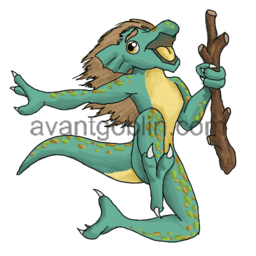 |
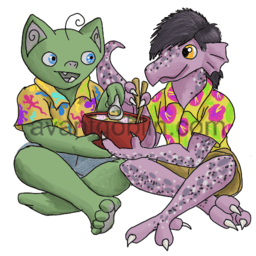 |
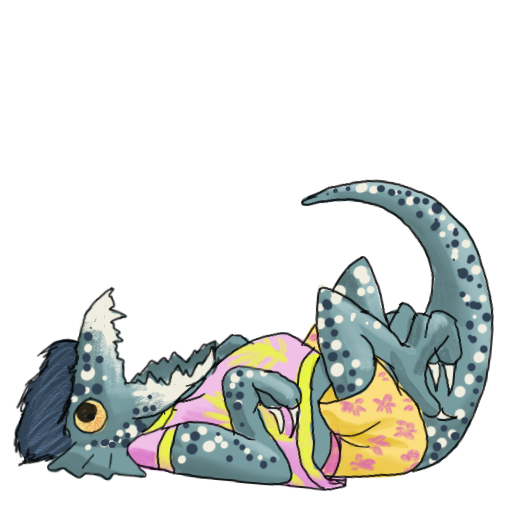 |
Kobold Husbandry
Kobolds are primarily male-gendered by default, but will transition to female as needed to produce eggs. Some transition back afterwards, and some do not. They lay soft-shelled eggs in clutches of one to four, with a short gestation period, and often eat the shell, sometimes before the egg has even hatched fully, leading to some urban legends of both live births and cannibalistic mothers. They cannot be cross-bred with any other known species.
Kobolds do not mate for life; they barely mate at all, but do stay together in the nest they were born in. In a clutch of eggs, usually only one will become an egg-layer for any length of time. She will leave her family to seek a temporary mate, and return with eggs to dump on her clutch-brothers. Sometimes she will transition back to male to help the boys out with the eggs (more common with one or no clutch-brothers), but often enough will remain female and wander off to whatever shenanigans, only returning with more eggs when the little ones are fending for themselves more and the boys have left them in the original nest and built a new one for the next clutch. Generational nests then pass to the first-borns, with parents establishing new nests for every set, stopping only when the eggs stop coming and they either settle in to the final, unusued nest, or when they simply stop building nests and wander off into the world as a form of retirement.
"Nests" are literal nests, built of usually sticks, but sometimes assorted found objects of an egg-defending sturdiness. A "new" nest may be as little as twenty feet away from the old nest, allowing several generations to help each other out with the hatchlings, forming colonies. These colonies can get fairly large if large game or a steady food source is available, but this rarely happens without a decent amount of infighting.
Kobolds do not age with grace; when they are no longer able to hunt or care for themselves, they become Food.
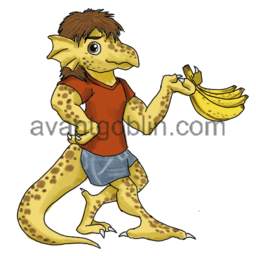 |
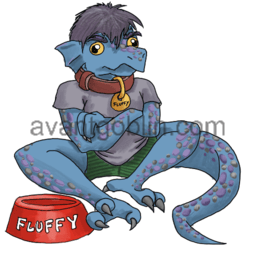 |
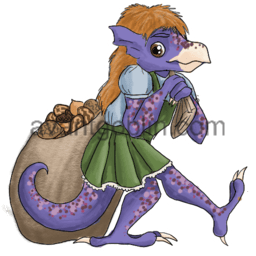 |
Cuisine
Like most sapient lizard types, kobolds live by the principle of "friend or food?". A Friend is to be kept alive as much as possible, but may become Food if they are dead and have no expressly stated wishes for the body. Food is any enemy, and can be summarily turned into more edible food by way of a swift dispatch and butchering.
Kobolds eat a LOT, like a surprising amount, and can eat just about anything, but strongly prefer meat or things with the texture of meat (like some mushrooms or fiberous vegetables). They turn to cannibalism alarmingly quickly in food-restricted scenarios, but will always go after Food and non-kobold Friends first. This carnivorism and reflective Friend or Food behavior leaves them in a somewhat parasitic state, usually near larger lizards (such as Lizardfolk or other human-sized-and-brained reptillians), powerful Salamancer colonies, or dragon lairs; things with more effective hunting abilities and enough excess to leave behind scavengable remains.
Kobolds do not do much in the way of "cooking" or "preparation," and most meals are served in a free-for-all frenzy, as early and often as possible. They're still happy to eat cooked food given the opportunity, but will rarely bother for themselves.
According to a brief and ill-fated survey of several types of dungeon monsters, kobolds are delicious, and their bones make excellent toothpicks.
 |
 |
 |
Kobold Culture; Alone and Assimilated
Kobolds are a fairly parasitic species, and rarely live in pure-kobold colonies with any degree of separation. Their preferred lodging is anywhere nearby something big and scary, as big and scary as possible, from which they will subsist off leftover food pickings, discarded scales or claws, take small treasures that will not be missed, and can even be seen caring for their host while it sleeps. They are rarely sought after and "welcomed", but may or may not be hunted or chased away, and can be considered functional minions in many settings. These parasitic colonies are typically all-kobold, with no cross-species action.
A Kobold that has chosen to leave their nest and strike out on their own will often find a surrogate nesting family or predatory; finding safety in an adventuring party or a colony of goblins or other such creatures who won't mind their presence. On some occasions, a solo kobold will be "adopted" into a household as a menial servant, fancy pet, and/or garbage disposal; most often by larger sapient lizards, or curious humans.
Additional Notes
Kobolds are considered a companion creature, and most of what is known about them at AvantGoblin is from the ones who have ventured far enough to join the goblins, and the stories they've told once here. At this time, suggestions and consultation is quite likely to become lore canon; get in touch!